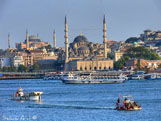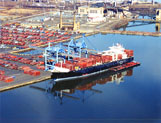Turkey
The SpecialEasts on the road for you:
Western europe. Eastern europe. Balkans. Turkey. CIS. Middle East. Central Asia.

Zenit offers the following services for Turkey:
You need to transport goods from or to Turkey? Just give us a call.
Our team will find the right solution for you!
Turkey - brief overview about the Zenit destination Turkey.
Geopraphy

Turkey is a transcontinental Eurasian country. Asian Turkey (made up largely of Anatolia), which includes 97% of the country, is separated from European Turkey by the Bosphorus, the Sea of Marmara, and the Dardanelles (which together form a water link between the Black Sea and the Mediterranean). European Turkey (eastern Thrace or Rumelia in the Balkan peninsula) comprises 3% of the country.
The territory of Turkey is more than 1,600 kilometres (1,000 mi) long and 800 km (500 mi) wide, with a roughly rectangular shape. Turkey's area, including lakes, occupies 783,562 square kilometres (300,948 sq mi), of which 755,688 square kilometres (291,773 sq mi) are in Southwest Asia and 23,764 square kilometres (9,174 sq mi) in Europe. Turkey is the world's 37th-largest country in terms of area, and is about the size of Metropolitan France and the United Kingdom combined. The country is encircled by seas on three sides: the Aegean Sea to the west, the Black Sea to the north and the Mediterranean Sea to the south. Turkey also contains the Sea of Marmara in the northwest.
The European section of Turkey, Eastern Thrace, forms the borders of Turkey with Greece and Bulgaria. The Asian part of the country, Anatolia (also called Asia Minor), consists of a high central plateau with narrow coastal plains, between the Köro?lu and Pontic mountain ranges to the north and the Taurus Mountains to the south. Eastern Turkey has a more mountainous landscape, and is home to the sources of rivers such as the Euphrates, Tigris and Aras, and contains Lake Van and Mount Ararat, Turkey's highest point at 5,165 metres (16,946 ft).
Turkey is divided into seven census regions: Marmara, Aegean, Black Sea, Central Anatolia, Eastern Anatolia, Southeastern Anatolia and the Mediterranean. The uneven north Anatolian terrain running along the Black Sea resembles a long, narrow belt. This region comprises approximately one-sixth of Turkey's total land area. As a general trend, the inland Anatolian plateau becomes increasingly rugged as it progresses eastward.
Demographics

The population of Turkey stood at 71.5 million with a growth rate of 1.31% per annum, based on the 2008 Census. It has an average population density of 92 persons per km². The proportion of the population residing in urban areas is 70.5%. People within the 15–64 age group constitute 66.5% of the total population, the 0–14 age group corresponds 26.4% of the population, while 65 years and higher of age correspond to 7.1% of the total population. Life expectancy stands at 70.67 years for men and 75.73 years for women, with an overall average of 73.14 years for the populace as a whole. Education is compulsory and free from ages 6 to 15. The literacy rate is 95.3% for men and 79.6% for women, with an overall average of 87.4%.The low figures for women are mainly due to the traditional customs of the Arabs and Kurds who live in the southeastern provinces of the country.
Article 66 of the Turkish Constitution defines a "Turk" as "anyone who is bound to the Turkish state through the bond of citizenship"; therefore, the legal use of the term "Turkish" as a citizen of Turkey is different from the ethnic definition. However, the majority of the Turkish population are of Turkish ethnicity. Other major ethnic groups (large portions of whom have been extensively Turkicized since the Seljuk and Ottoman periods) include the Abkhazians, Adjarians, Albanians, Arabs, Assyrians, Bosniaks, Circassians, Hamshenis, Kurds, Laz, Pomaks, Roma, Zazas and the three officially recognized minorities (per the Treaty of Lausanne), i.e. the Armenians, Greeks and Jews. Signed on January 30, 1923, a bilateral accord of population exchange between Greece and Turkey took effect in the 1920s, with close to 1.5 million Greeks moving from Turkey and some 500,000 Turks coming from Greece.Minorities of West European origin include the Levantines (or Levanter, mostly of French, Genoese and Venetian descent) who have been present in the country (particularly in Istanbul and ?zmir) since the medieval period; or the Bosporus Germans and Istanbul Poles who have lived in Turkey since the 19th century. There is also a population of Afro-Turks within Turkey who mostly live in the western coastal cities of the country and are largely mixed with the local population through intermarriage. The Kurds, a distinct ethnic group concentrated mainly in the southeastern provinces of the country, are the largest non-Turkic ethnicity. Minorities other than the three officially recognized ones do not have any special group privileges, while the term "minority" itself remains a sensitive issue in Turkey. Reliable data on the exact ethnic repartition of the population is not available since the Turkish census figures do not include racial figures.
Economy
Turkey has the world's 13th largest GDP by PPP[236] and 18th largest nominal GDP.[237] The country is among the founding members of the OECD and the G-20.[164][170]
The EU – Turkey Customs Union in 1995 led to an extensive liberalisation of tariff rates, and forms one of the most important pillars of Turkey's foreign trade policy.[238] Turkey's exports were $143.5 billion in 2011 and reached $163 billion in 2012 (main export partners in 2012: Germany 8.6%, Iraq 7.1%, Iran 6.5%, UK 5.7%, UAE 5.4%). However, larger imports which amounted to $229 billion in 2012 threatened the balance of trade (main import partners in 2012: Russia 11.3%, Germany 9%, China 9%, US 6%, Italy 5.6%).[9]
Turkey has a sizeable automotive industry, which produced over 1.3 million motor vehicles in 2015, ranking as the 14th largest producer in the world.[239] Turkish shipbuilding exports were worth US$1.2 billion in 2011.[240] The major export markets are Malta, Marshall Islands, Panama and the United Kingdom. Turkish shipyards have 15 floating docks of different sizes and one dry dock.[240] Tuzla, Yalova, and İzmit have developed into dynamic shipbuilding centres.[241] In 2011, there were 70 active shipyards in Turkey, with another 56 being built.[241] Turkish shipyards are highly regarded both for the production of chemical and oil tankers up to 10,000 dwt and also for their mega yachts.[241]
Beko and Vestel are among the largest producers of consumer electronics and home appliances in Europe.
Turkish brands like Beko and Vestel are among the largest producers of consumer electronics and home appliances in Europe, and invest a substantial amount of funds for research and development in new technologies related to these fields.[242][243][244]
Other key sectors of the Turkish economy are banking, construction, home appliances, electronics, textiles, oil refining, petrochemical products, food, mining, iron and steel, and machine industry. In 2010, the agricultural sector accounted for 9 percent of GDP, while the industrial sector accounted for 26 percent and the services sector for 65 percent.[9] However, agriculture still accounted for a quarter of employment.[245] In 2004, it was estimated that 46 percent of total disposable income was received by the top 20 percent of income earners, while the lowest 20 percent received only 6 percent.[246] The rate of female employment in Turkey was 30 percent in 2012,[247] the lowest among all OECD countries.[248]
Climate
The coastal areas of Turkey bordering the Aegean and Mediterranean Seas have a temperate Mediterranean climate, with hot, dry summers and mild to cool, wet winters.[234] The coastal areas bordering the Black Sea have a temperate oceanic climate with warm, wet summers and cool to cold, wet winters.[234] The Turkish Black Sea coast receives the greatest amount of precipitation and is the only region of Turkey that receives high precipitation throughout the year.[234] The eastern part of that coast averages 2,200 millimetres (87 in) annually which is the highest precipitation in the country.[234]
The coastal areas bordering the Sea of Marmara, which connects the Aegean Sea and the Black Sea, have a transitional climate between a temperate Mediterranean climate and a temperate oceanic climate with warm to hot, moderately dry summers and cool to cold, wet winters.[234] Snow falls on the coastal areas of the Sea of Marmara and the Black Sea almost every winter, but usually melts in no more than a few days.[234] However snow is rare in the coastal areas of the Aegean Sea and very rare in the coastal areas of the Mediterranean Sea.[234]
Mountains close to the coast prevent Mediterranean influences from extending inland, giving the central Anatolian plateau of the interior of Turkey a continental climate with sharply contrasting seasons.[234]
Winters on the eastern part of the plateau are especially severe.[234] Temperatures of −30 to −40 °C (−22 to −40 °F) can occur in eastern Anatolia.[234] Snow may remain at least 120 days of the year.[234] In the west, winter temperatures average below 1 °C (34 °F).[234] Summers are hot and dry, with temperatures often above 30 °C (86 °F) in the day.[234] Annual precipitation averages about 400 millimetres (16 inches), with actual amounts determined by elevation. The driest regions are the Konya plain and the Malatya plain, where annual rainfall is often less than 300 millimetres (12 inches). May is generally the wettest month, whereas July and August are the driest
Infrastructure

In 2013 there were 98 airports in Turkey,[280] including 22 international airports.[281] As of 2015, Istanbul Atatürk Airport is the 11th busiest airport in the world, serving 31,833,324 passengers between January and July 2014, according to Airports Council International.[282] The new (third) international airport of Istanbul is planned to be the largest airport in the world, with a capacity to serve 150 million passengers per annum.[283][284][285] Turkish Airlines, flag carrier of Turkey since 1933, was selected by Skytrax as Europe's best airline for five consecutive years in 2011, 2012, 2013, 2014 and 2015.[277][278][286] With 435 destinations (51 domestic and 384 international) in 126 countries worldwide, Turkish Airlines is the largest carrier in the world by number of countries served as of 2016.[279]
The Osman Gazi Bridge, located at the Gulf of İzmit, is the fourth-longest suspension bridge in the world by the length of its central span.[287]
As of 2014, the country has a roadway network of 65,623 kilometres (40,776 miles).[288] The total length of the rail network was 10,991 kilometres (6,829 miles) in 2008, including 2,133 kilometres (1,325 miles) of electrified and 457 kilometres (284 miles) of high-speed track.[289][290] The Turkish State Railways started building high-speed rail lines in 2003. The Ankara-Konya line became operational in 2011, while the Ankara-Istanbul line entered service in 2014.[290] Opened in 2013, the Marmaray tunnel under the Bosphorus connects the railway and metro lines of Istanbul's European and Asian sides; while the nearby Eurasia Tunnel (2016) provides an undersea road connection for motor vehicles.[291] The Bosphorus Bridge (1973), Fatih Sultan Mehmet Bridge (1988) and Yavuz Sultan Selim Bridge (2016) are the three suspension bridges connecting the European and Asian shores of the Bosphorus strait. The Osman Gazi Bridge (2016) connects the northern and southern shores of the Gulf of İzmit. The planned Çanakkale Bridge will connect the European and Asian shores of the Dardanelles strait.
In 2008, 7,555 kilometres (4,694 mi) of natural gas pipelines and 3,636 kilometres (2,259 mi) of petroleum pipelines spanned the country's territory.[289] The Baku-Tbilisi-Ceyhan pipeline, the second longest oil pipeline in the world, was inaugurated on 10 May 2005.[292] The Blue Stream, a major trans-Black Sea gas pipeline, delivers natural gas from Russia to Turkey. A planned undersea pipeline, Turkish Stream, with an annual capacity around 63 billion cubic metres (2,200 billion cubic feet), will allow Turkey to resell Russian gas to Europe while planned Nabucco pipeline will reduce European dependence on Russian energy
More Information: http://en.wikipedia.org/wiki/Turkey
Text is available under the Creative Commons Attribution-ShareAlike License; additional terms may apply. See Terms of Use for details.
Wikipedia® is a registered trademark of the Wikimedia Foundation, Inc., a non-profit organization.

 Deutsch
Deutsch Turkce
Turkce Russian
Russian